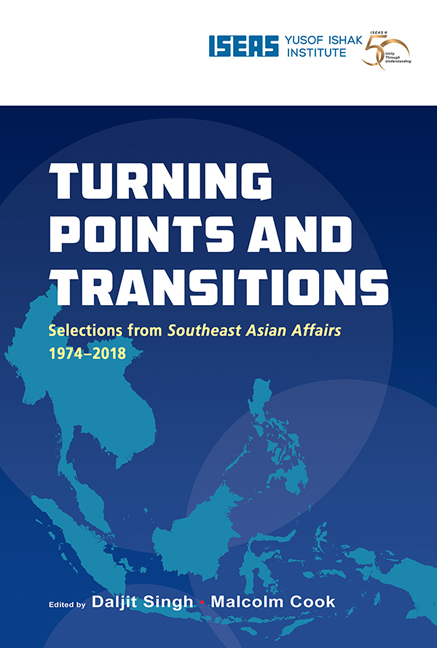Book contents
- Frontmatter
- Contents
- Message from the Director
- Foreword
- Foreword
- Introduction
- THE REGION
- BRUNEI
- CAMBODIA
- INDONESIA
- LAOS
- MALAYSIA
- MYANMAR
- THE PHILIPPINES
- An Overview of the Philippines (1974)
- Unfinished Revolution: The Philippines in 1986 (1987)
- Terrorism: Evolving Regional Alliances and State Failure in Mindanao (2006)
- SINGAPORE
- THAILAND
- VIETNAM
An Overview of the Philippines (1974)
from THE PHILIPPINES
Published online by Cambridge University Press: 29 May 2019
- Frontmatter
- Contents
- Message from the Director
- Foreword
- Foreword
- Introduction
- THE REGION
- BRUNEI
- CAMBODIA
- INDONESIA
- LAOS
- MALAYSIA
- MYANMAR
- THE PHILIPPINES
- An Overview of the Philippines (1974)
- Unfinished Revolution: The Philippines in 1986 (1987)
- Terrorism: Evolving Regional Alliances and State Failure in Mindanao (2006)
- SINGAPORE
- THAILAND
- VIETNAM
Summary
On 23 September 1972 President Marcos invoked martial law under the country's Constitution to meet what he termed “the threat of a violent overthrow of our Republic” and “to reform the social, economic and political institutions in our country.” Simultaneously there was an almost total clampdown on the press, television and radio stations, and the mass arrest of prominent citizens, among them opposition politicians and publishers. The declaration of martial law was quickly followed by a number of vigorous measures aimed at controlling the possession of weapons and weeding out the corrupt and incompetent within the government service, and bringing certain basic industries and communications under state control. It is noteworthy that although the communist threat was the justification for martial law the initial measures of martial law rule could also be seen as having been aimed at breaking the power of the oligarchy such as the arms’ ban, detention of political opponents, appropriation of private property, seizure of newspapers and the initial ban on foreign travel.
The immediate reaction of political observers to the imposition of martial law was that it was a move on the part of President Marcos to perpetuate his power indefinitely and suppress all criticisms against his rule which had been mounting since his re-election in 1969. The ordinary Filipino however, tired of the increasing violence and anarchy in Manila during the months preceding September, and burdened by serious food shortages and spiralling prices following devastating floods in June 1972 was more anxious to see the implementation of much needed reforms in the country and the reconstruction of what President Marcos has proudly proclaimed as the New Society.
One of the first to benefit from martial law was the armed forces. On 30 September 1972 President Marcos announced increased rates of monthly pay for the enlisted personnel of the Philippine Armed Forces, increased monthly pay for commissioned officers and promotions for a number of officers. While reforms and improvements in the armed forces had for long been recommended, the Presidential Order coming almost immediately after martial law had the appearance that it was made with the aim of ensuring military backing for the President. Since the imposition of martial law the armed forces have been brought increasingly to the fore with increased political and administrative responsibilities.
- Type
- Chapter
- Information
- Turning Points and TransitionsSelections from Southeast Asian Affairs 1974-2018, pp. 543 - 547Publisher: ISEAS–Yusof Ishak InstitutePrint publication year: 2018



